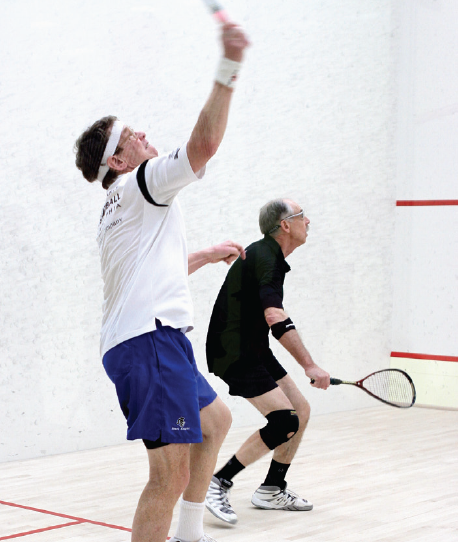By Candace Chemtob, B.S. and M.S. in Human Nutrition
Knees, shoulders, hips, back… Joint problems can bring a squash career to a quick halt. Longevity in your sport could have a lot to do with your joint health. Keeping your joints strong and healthy can be influenced by training, previous injuries, and other factors including diet.
A joint is the physical point at which two or more bones meet. Joints can be immobile, like those in the skull, or mobile, like the knee, hip or elbow joints. Characteristically, mobile joints have cartilage, special covering on the surface of bones, whose primary function is to keep the bones from rubbing against each other. Joints are held together by ligaments and tendons, which are tough bands of connective tissue that support the joint’s movement. The surrounding muscles serve to further stabilize the joint.
When a joint becomes injured, whether from movement, overuse, or disease, the body reacts similarly. The first line of defense is to send nutrients and disease fighting cells to the injured tissue resulting in a build up of fluids—or inflammation of the joint. This inflammatory response initiates the healing process but results in joint redness, tenderness, and sometimes pain. Unfortunately, this response, especially if a repeated injury, can have the unintended effect of damaging body tissues and lead to long term joint problems.

Arthritis is inflammation of the joints and can affect people of all ages. The most common form of arthritis is osteoarthritis from which over 26 million Americans suffer. Osteoarthritis occurs when the cartilage in a joint “wears away” over time, allowing the bones to rub together. Autoimmune forms of arthritis, such as rheumatoid and psoriatic arthritis, and other disease processes like gout, also cause inflammation of the joints independent of movement (sports) injury or overuse.
Every athlete, whether a beginner or elite, old or young, should make it a priority to protect their joints. Here are some tips to keep your joints strong and healthy:
Maintain a healthy weight. Excess weight increases the strain on joints and is associated with an increased incidence of osteoarthritis.
Strengthen your joints through exercise. Exercise keeps the muscles around your joint strong and helps support them (ACSM.org). If you already have sports-related injuries or arthritis, a physical therapist can develop an individualized program for you.
Warm up. The muscles that stabilize your joints will respond better to the demands of exercise if you warm up which gradually increases blood flow to those muscles and prepares you for the physical demands of squash.
Wear proper footwear. Squash is a running (impact) sport that can take a toll on your joints. Proper shoes will help support your feet and cushion your body from the stress of our impact sport.
Be protective of your joints. Repetitive damage to a joint over time can lead to osteoarthritis. Although moderate exercise may strengthen joints and help stave off injury, “excessive participation in high impact sports, particularly over a long period of time and at an elite level, can increase the risk of developing osteoarthritis” (Saxon, Sports Med, 1999).
Glucosamine and chondrotin: The evidence supporting these supplements has been conflicting, making recommendations controversial. The National Institutes of Health states that glucosamine and chondrotin do not prevent arthritis, but in the case of moderate or severe arthritis, may reduce the pain of arthritis (nih.gov).
Eat an “anti-inflammatory” diet. Much attention has been paid to the inflammatory response the past few years, as it’s far-reaching effects are being discovered. Modifying your inflammatory response to help your joints, will also have a beneficial effect on your overall health and may reduce your risk of cardiovascular disease, diabetes, and some forms of cancer.
Omega 3 fatty acids have been shown to decrease chronic inflammation. Boost your intake of foods high in omega 3s: fatty fish (salmon, tuna, mackerel, anchovies), walnuts, and flax seeds. Consider taking Omega 3 supplements.
Eat a diet rich in fruits and vegetables. Fruits and vegetables have anti-inflammatory properties and are high in antioxidants. Research has supported this claim showing that diets rich in fruits and vegetables decreases markers (biochemical signs of) inflammation and oxidative stress (Holt, J Am Diet Assoc, 2009). Aim for 8 to 10 servings per day.
Choose high fiber foods. Your diet should have a minimum of 30g fiber per day. An increase in dietary fiber is associated with a decrease in the inflammatory response, decreased blood sugar levels, decreased blood lipids, and reduction in risk of certain types of cancer including colon cancer.
Spice it up! Recent research has focused on the anti-inflammatory properties of some spices. Although the evidence could still be disputed, there is little downside to including a little more spice in your diet. The spices that have been suggested to play an anti-inflammatory role are cinnamon, tumeric, and ginger.
There is no downside to protecting your joints! Whether paying attention to your training regimen, foot wear, or improving your overall health by maintaining a healthy weight and eating an anti-inflammatory diet, if you can protect your joints, you will find yourself on the squash court for many years to come!


